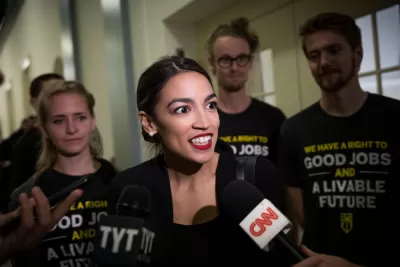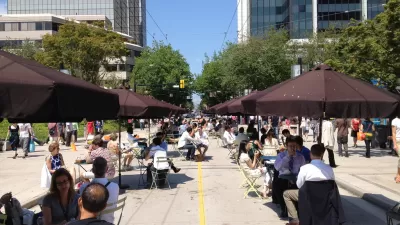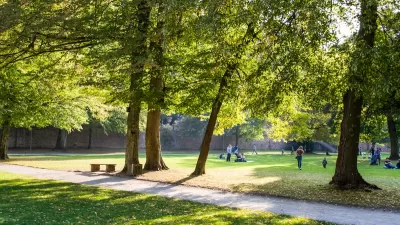If it emulated and adapted the scope of its predecessor, the Green New Deal could transform the country in fundamental ways, with builders, planners, and architects playing central roles.

Two futures may be in store for the country, Kelsey Campbell-Dollaghan writes. "Escalating storms, floods, droughts, mass migration, food scarcity, and economic instability could dramatically alter the physical landscape and economy." Or, more optimistically, "A national effort to retrofit millions of buildings and rethink the way communities are designed could help Americans withstand the ravages of climate change and make the country more equitable."
Discussing issues of bureaucratic reform, land use, architecture, labor, and equity, Campbell-Dollaghan outlines what it might take to implement the Green New Deal. That includes environmental retrofits for "tens of millions of houses and apartment buildings," an endeavor that would employ an immense workforce and necessitate a lot more federal oversight of local affairs.
The Green New Deal also bakes in an explicit focus on equity, with consequences for housing affordability and the workforce. "A renovation program on this scale could have many unintended effects" on vulnerable populations that policymakers would need to address.
Campbell-Dollaghan also discusses how the Green New Deal could truly engage architects and designers in the oft-talked about project of sustainable, equitable development. "The resolution poses an opportunity for architects and designers to reclaim their relevance to society, not as service providers for wealthy clients but as vocal leaders on major issues in the built world, like social justice and climate change."
FULL STORY: The Green New Deal could change the way America builds—here’s how

Planetizen Federal Action Tracker
A weekly monitor of how Trump’s orders and actions are impacting planners and planning in America.

Chicago’s Ghost Rails
Just beneath the surface of the modern city lie the remnants of its expansive early 20th-century streetcar system.

San Antonio and Austin are Fusing Into one Massive Megaregion
The region spanning the two central Texas cities is growing fast, posing challenges for local infrastructure and water supplies.

Since Zion's Shuttles Went Electric “The Smog is Gone”
Visitors to Zion National Park can enjoy the canyon via the nation’s first fully electric park shuttle system.

Trump Distributing DOT Safety Funds at 1/10 Rate of Biden
Funds for Safe Streets and other transportation safety and equity programs are being held up by administrative reviews and conflicts with the Trump administration’s priorities.

German Cities Subsidize Taxis for Women Amid Wave of Violence
Free or low-cost taxi rides can help women navigate cities more safely, but critics say the programs don't address the root causes of violence against women.
Urban Design for Planners 1: Software Tools
This six-course series explores essential urban design concepts using open source software and equips planners with the tools they need to participate fully in the urban design process.
Planning for Universal Design
Learn the tools for implementing Universal Design in planning regulations.
planning NEXT
Appalachian Highlands Housing Partners
Mpact (founded as Rail~Volution)
City of Camden Redevelopment Agency
City of Astoria
City of Portland
City of Laramie





























